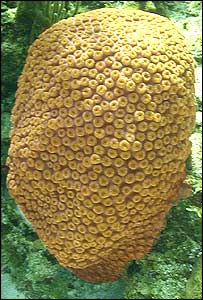
The coral glows orange during the day. The height of the colony is about 60 cm
Scientists have discovered "illuminating" corals in the Bahamas. Apparently, there is nothing new in this phenomenon, because many species of corals are known for the soft glow that is spread by proteins they produce, usually green in color. But Dr. Michael Lesser of New Hampshire said that the coral colonies of the "big star" type that he and his friends encountered are a completely different thing. According to him, "It was daylight at a depth of 10 meters, without any additional light sources", it was a prominent orange fluorescent light.
Dr. Lesser and his colleagues discovered that, unlike other corals, the emitted light is not produced by the microorganisms that build the corals, but by cyanobacteria, known as blue-green algae.
Lesser said that the blueness helps break down nitrogen in the water in a way that makes it easier for the corals to digest it. According to him, this is the first record of the bacteria living inside coral tissues. Until now, scientists believed that corals and dinoflagellate algae, which carry out photosynthesis, existed in a bilateral symbiosis between them. But in the case that was discovered, it is a tripartite sebmiosis between the corals, the blue-green algae and the dinoflagellate.
Dr. Lesser explained that in most cases the algae produce somewhat limited food for the corals. "We call it the Junko Food Diet," Lesser said. "The algae produce the carbon but do not supply the nitrogen." In the case of the big blue star colonies, they make up for the deficiency in nitrogen and, apparently, receive glycerol from the dinoflagellate algae in return. An alternative hypothesis of the researchers is that corals survive by eating the blue-green algae.
However, Dr. Lesser qualified the findings and said that the amount of nitrogen processed by the cyanobacteria has not yet been tested and therefore it is difficult to reach definitive conclusions. However, Lesser adds that at the very least it appears that the previous assumptions about how the coral exists were wrong.
